1953
– 1963 Seasons
Since
1953, year in which the World Championship of Makes was reglamented,
there have been many formulaes that have defined this category.
In
its inception, it covered vehicles that were half Gran Turismo and
half Prototypes, under the name Sport. For the newbies, this two-seater
apparatusses with windshields that litterally wrapped the cockpit, were the
closest thing to the image that they had of a daily use sports car.
But
that image did not last very long, due to a series of realities. The
Championship was something difficult to obtain, and the carmakers saw in it as a huge
publicity source. The ambition to be in the spotlight, forced them to perfect
the cars year after year.
In
the beggining, the metamorphosis was slow, but as soon as races such as the Mille
Miglia and the Panamericana dissapeared, the process
evolved very quickly. The cockpits became more crowded, the lines were lower,
and the baggage space became smaller...
The
regulations were semi-directed by the Automobile Club de´l Ouest, entity
that organizes the 24 Hours of Le Mans, the prime attraction of
the category, until the commercial interests overtook her. Thus, succesive
modifications in the regulations encouraged the participation during the sixties,
the decade of the American "monsters", who took the category for
themselves, sweeping the competition away with the undeniable prowess of its 500
brake horse power and 7-litre engines.
|
The
“Sports” category was created in 1953. Until 1965, Ferrari had won all of
the championships excepting the 1955 (Mercedes Benz 300 SLR - Fangio) and 1959
(Aston Martin).
The
1961,´62, and ´63 championships were not difficult at all for Ferrari, given
the absence of strong rivals, but in 1964 a monstrous investment plan, puts Ford
in the expectative seat.
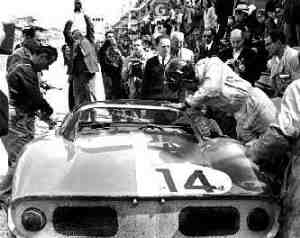
Ferrari 250P - 1963 |
In 1961, a V6
mid-engined Ferrari spyder
was the first to use a spoiler on the rear deck. The spoiler "welled
up" the airflow on the deck creating a high pressure area and thus reducing
lift at the rear. The spoiler was widely used in the 1960's and a prime
example was the Le Mans-winning Ferrari 250P. Tire advances allowed 1 G
cornering in the early 60's |

TEMPORADA
1964
Although the
Ford GT40's had serious transmission problems, and abandoned most of the races, the
Le Mans and Reims straights put them as the fastest cars in the
category.
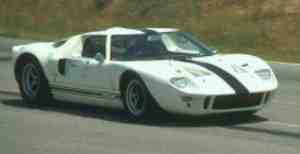
A
Ferrari 275P (Guichet-Vacarella) wins Le Mans and, after the triumphs in
Sebring,
Reims, Paris 1000 kms., and the Nürburgring, they win the
championship.
In
1963 the Porsche 904 Carrera GTS had been introduced. This model is considered
by Porsche AG as the predecessor of the prototypes that dominated the raceways
at the end of the sixties and beginning of the seventies.
|
THE
WINNERS
|
| 1953 |
Ferrari |
| 1954 |
Ferrari |
| 1955 |
Mercedes
Benz |
| 1956 |
Ferrari |
| 1957 |
Ferrari |
| 1958 |
Ferrari |
| 1959 |
Aston
Martin |
| 1960 |
Ferrari |
| 1961 |
Ferrari |
| 1962 |
Ferrari |
| 1963 |
Ferrari |
| 1964 |
Ferrari |
| 1965 |
Ferrari |
| 1966 |
Ford |
| 1967 |
Ferrari |
| 1968 |
Ford |
| 1969 |
Ford |
| 1970 |
Porsche |
| 1971 |
Porsche |
The
904 Carrera's were powered by different powertrains: 1 eight cylinders, various
versions of the six-cylinder, but they basically used a 2-Litre four cylinder
engine. The power developed by this engine, reached the 180 bhp @ 7200 rpm's;
more than enough to reach 260 km/h as a top speed, with acceleration figures to
100 km/h under 6 seconds. They weighed 650 kg's.
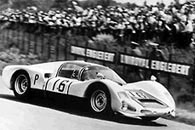 |

|
| PORSCHE
906 Carrera 6
1000
km. Nürburgring 1966 Pilotos: Udo Schütz/Günther Klass |
904
Carrera GTS |
| Photos
from the official Porsche
website
|
 |
 |
| PORSCHE
904 GTS |
|
Fotos
de R. Hezard
|
|
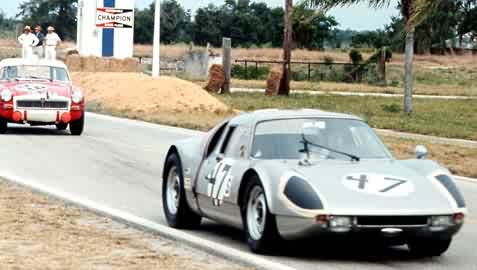
Photo
by LAT - www.speedvision.com/pub/sitelet/porsche2000/gallery.html
|

1965
Season
The
Ferrari-Ford confrontation was
more alive than ever. As always, the primary target for that year was the 24
Hours of Le Mans.
By
the time Le Mans was the next race, Ford had won the 2000 km of Daytona and
Ferrari had had it’s share at Sebring, Monza, Targa Florio and
Nürburgring.
The
Ford entry consisted in the brand new 7-litre car, as the Ferrari lineup
included the following models: 330 P2, 275 P2, 275 LM and 365 P.
Ford
had 6 cars on the starting grid, and Ferrari had 10, but all of the 16 works
cars either abandon or fail to make it into the contenders group, and a
privately- entered N.A.R.T. Ferrari 275 LM wins the race.
At the end of the season, and thanks to the
Cobra model,
Ford conquers the Sport Championship, which was independent to the Prototype
Championship, which fell into Ferrari’s hands.

1966
Season
The great duel is about to take place.
Ford
prepares another 7-litre and Ferrari remains with its 4-litre V12. In the first
race of the year, the Daytona 24 hours, Ferrari doesn’t show up, leaving the
race to Ford.
The
second round takes place in SPA Francorchamps where the Ferrari P3 beats the
Ford MkIII, repeating the victory at Monza, but succumbs at the
Nürburgring and
the Targa Florio.
Le
Mans arrives, and no less than eight Ford MkIII and seven Ferrari are at the
starting grid. Ford takes a top three finish and not one Ferrari comes close to
a good finish. America had beaten Europe.
There
are lots of arguments to justify Ford’s victory, but the most common of all is
the huge amounts of dollars behind every MkIII.

1967
Season
At mid-year,
Ferrari, with it’s 275
LM was fighting hard against the GT40´s for the Sports Championship, while
another battle –this one against Porsche- took place for the Prototype
Championship.
At the
24 hours of Le Mans, and in
spite that Ferrari enters eight cars, the Ford MkIV gets the victory in an
astounding form. A few days later Ferrari defines both the Sports and the
Prototypes Championships at Brands Hatch, where it defeats Ford and
Porsche, respectively.
In 1967
Porsche raced with it’s new models, the 910 and 907 with tubular chassis.
|
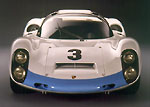
|
The 910 had
a 2.0 or 2.2 litre engine, with 8 or 6 cylinders, with power ranging from 220 to
272 bhp. It weighed between 600 and 620 kg. (Spyder 450 kg.)
Photo from
the official Porsche website |
|
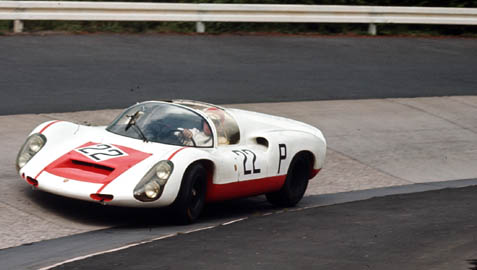
Foto
by LAT - www.speedvision.com/pub/sitelet/porsche2000/gallery.html
|
The
907 was
an aerodynamically improved version and it debuted at the 24 Hours of Le Mans in
1967. It’s biggest success was obtained at the 24 hours of Daytona in 1968,
where it took a top three podium.
|
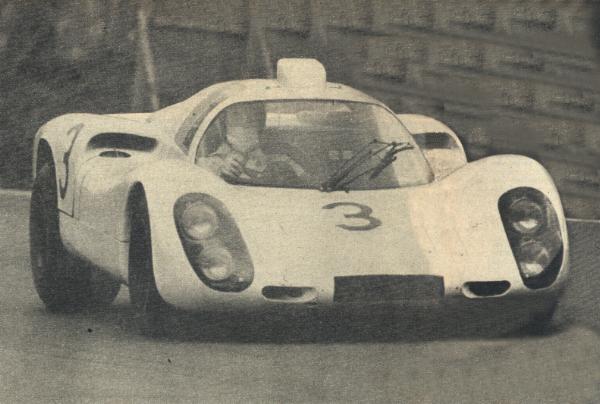
|
|
The Porsche 907:
Eight cylinders,2195 cm3. 270 BHP. First
absolute victories for Porsche at Daytona, Sebring and the Targa Florio in
1968. The car that opened the way to the 3-litre 908´s.
|

 Previous Previous |
 To
1968 Season To
1968 Season
|
INDEX
 |
HOME |
Webmaster
IngeWeb









